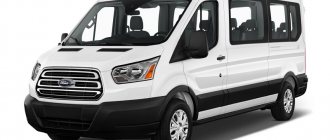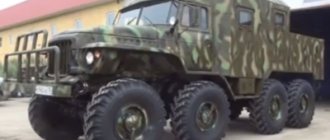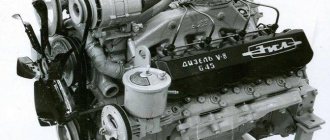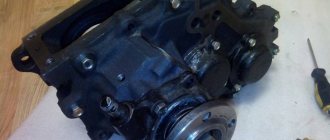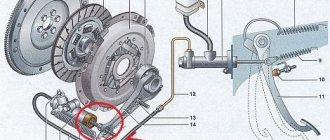SUVs are equipped with a 2-axle drive system, which allows you to drive on soft ground or in off-road conditions. The car owner needs to know how to enable all-wheel drive on a UAZ Patriot, which can be equipped with transfer gearboxes of several types (this depends on the year of manufacture of the vehicle). Depending on the gearbox model, a lever or a rotary washer is used to shift.
Washer or lever for switching the drive.
How the all-wheel drive system works
The Patriot's engine is connected to a 5-speed synchronized manual transmission. The secondary shaft of the box transmits torque to a 2-stage transfer gearbox, which is connected to the axles using cardan shafts with needle bearings and movable couplings. Splined couplings ensure the operation of the transmission when the axle moves on a suspension. The drive to the rear beam operates in continuous mode; the driver turns on the front axle of the UAZ Patriot when driving off-road.
The classic UAZ transfer gearbox is equipped with gears with straight teeth, which are switched using a lever. The gearbox housing parts are made of cast iron, the primary and secondary shafts are located inside, and there is an intermediate element with a movable carriage. The gearbox cover houses a switching mechanism equipped with two rods and forks. The mechanism is connected to a lever located inside the car.
The Dymos gearbox (with an aluminum crankcase), used since the summer of 2013, uses a chain to transmit power to the wheels, and the design includes a double synchronizer (when all-wheel drive is engaged in direct drive). The manufacturer claims a gearbox life of 200 thousand km, but with frequent use of the vehicle in severe off-road conditions, the unit fails earlier. To change gears, an electric servo drive is used, connected to a control puck.
The car's all-wheel drive distributes torque between the axles in a 50/50 ratio. There is no center differential in the transmission design. The rear axle is equipped with a differential; axle shafts installed inside the axle stockings are used to transmit torque to the wheels. To supply torque to the front wheels, axle shafts and steering knuckles with hinges are used. The units allow power to be transmitted to the steered wheels. The front axle housing also has a cross-axle differential.
On cars manufactured before 2007, factory couplings (hubs) were installed in the front wheel hubs. The devices allow you to disconnect the hubs from the axle shafts and differential, which has a positive effect on fuel consumption. The products are equipped with splined couplings; a special rotary washer in the center of the hub is used to control the position. The plant refused to install hubs on the UAZ in order to simplify the design of the vehicle, but owners of Patriot vehicles can install the hubs themselves.
Oil change process
To change the lubricant you need to:
- Warm up the lubricant. To do this, drive a car from 2 to 4 kilometers. Hot transmission oil will leak out of the crankcase faster;
- Place the car on a pit or overpass;
- Install anti-roll devices under the wheels;
- Clean the filler and drain plugs from dirt with a wire brush;
- Prepare a container with a volume of at least 1 liter. It is necessary to collect used oil. It is better to choose a container with a wide neck;
- Unscrew the filler plug. Necessary for air mass to enter the crankcase;
- Place a container under the drain hole and unscrew the plug. To avoid burns, it is necessary to prevent hot lubricant from coming into contact with exposed areas of the body;
- Clean the inside of the plugs from dirt and metal shavings;
- Screw in the drain plug;
- Add oil. For this, specialized syringes or pumps are used. The oil level should be at the bottom edge of the filler neck;
- Tighten the filler plug.
After completing the procedure, it is necessary to eliminate oil leaks that formed when replacing the lubricant. This is necessary for further control over the tightness of the unit. It is recommended to check the fluid level in the crankcase after the car has traveled 15,000 kilometers.
From the above it follows that the transfer case of the UAZ Patriot is a reliable transmission unit. RK components are highly durable. For normal operation of the unit, it is necessary to carry out regular maintenance. Failure to promptly replace the lubricant in the crankcase can lead to jamming of the mechanism or rapid wear of parts.
Turning on all-wheel drive on a UAZ Patriot
On UAZ vehicles assembled before 2013, there is a standard UAZ Patriot transfer case. To change operating modes, a separate lever is used, located on the tunnel between the front seats. The handle allows you to turn the drive to the front axle on or off, as well as select direct or reduced speed in the gearbox. A spherical plate is mounted on the handle, on which the gearbox switching algorithm is indicated.
After the introduction of the Hyundai Dymos transfer gearbox (developed in South Korea), a rotary washer mounted on the center console is used to switch transmission modes.
The use of electronics allows you to turn on the all-wheel drive mode on the go (at speeds up to 100 km/h). But to engage a downshift, you need to stop and move the main gearbox lever to the neutral position (with the clutch released). Then the washer is moved to the right, and the UAZ Patriot clutch is depressed until the indicator on the panel turns on.
Operating modes of the Dymos gearbox:
- Standard 2H, used when operating a vehicle on highways or dirt roads with hard surfaces (in summer and winter).
- All-wheel drive mode with direct 4H transmission, activated when driving on wet or slippery dirt or asphalt roads. When the drive is turned on, a control indicator on the instrument panel is activated. The factory recommends switching the mode only when driving in a straight line. Activation of the drive on 2 axles when moving in an arc leads to shock loads on the transmission units. If, when turning the washer, the drive to the front axle does not turn on, then you need to increase or decrease the speed and then try again.
- The lowered row 4L is used when driving in difficult road conditions or when moving a trailer through mud or deep snow (up to 400 mm or more). The mode provides an increase in torque at the wheels; a warning lamp lights up on the instrument cluster. When driving, it is forbidden to jerk the car sharply with the engine, since the chain mechanism does not tolerate shock loads and is destroyed.
Dymos transfer case with gear ratio 4.11.
When all-wheel drive is connected, the gearbox may produce extraneous sounds accompanied by body vibration. When operating a vehicle with front axle drive, controllability deteriorates (the angle of rotation of the wheels decreases), and vibrations occur when the steering wheel rotates. The use of the drive on dry roads leads to increased fuel consumption and additional noise, and also negatively affects the service life of tires and transmission components.
To return to rear-wheel drive mode, you need to release the gas pedal and then press the clutch. At the same time, the washer is rotated to the 2H position. After the 4H indicator goes out on the instrument cluster display, the clutch pedal is released. To shift from a lower gear to a direct gear, you need to stop the car, then press the clutch pedal, then move the washer from position 4L to position 4H, wait until the indicator turns off and release the clutch.
When operating machines with a Dymos gearbox, a malfunction occurs due to spontaneous activation of the all-wheel drive. The defect is associated with erroneous switching of the unit control unit.
To restore functionality, you will need to repair the controller or replace the part along with the rotary washer. The design of the gearbox provides a diagnostic system: when faults are detected, the 4WD Check indicator turns on in the instrument cluster with simultaneous activation of the indicator of the operating mode in which the problem was detected.
Dymos gearbox diagram.
Transfer case repair
If a unit breaks down, it must be repaired. Troubleshooting electronic distribution systems is carried out by qualified specialists. A mechanically controlled device can be repaired independently if you have skills in repairing equipment. You can also read about the UAZ “Bukhanka” cooling system.
Removing the unit
Removal of the UAZ Patriot transfer case is carried out in the following sequence:
- Place the car on a pit, overpass or lift;
- Immobilize the vehicle. For this purpose, anti-roll devices are installed under the wheels;
- Engage neutral gear on the gearbox and switchgear;
- Lower the parking brake lever;
- Unscrew the plug for filling the lubricant;
- Place a container to collect used lubricant under the drain hole and drain the oil;
- Mark the position of the driveshaft flanges in relation to the transfer case flanges;
- Unscrew the fastening bolts and disconnect the front and rear driveshafts;
- Remove the sunroof installed on the floor in the car interior and the shift lever cover;
- Unscrew the bolt securing the lever to the transfer case shaft;
Transfer case lever positions and their meanings
The classic transfer gearbox is controlled using a separate handle. The lever moves along a path in the shape of the letter P; there are a total of 4 handle positions. The position in which the lever is at the lower left point of the letter P is considered neutral.
When using a gearbox, you should take into account the presence of hubs in the front wheel hubs (installed at the factory until 2007, and then by the owners themselves). If there are elements on the machine, then it is necessary to first activate the drive by turning the handles on the hubs.
Positions of the gearbox control lever on the UAZ “Patriot”:
- To disable the drive to the front axle, move the handle to the base position. In this case, torque is transmitted to the rear wheels. This operating mode is intended for operating the vehicle on paved roads in summer or winter. The plant recommends using the mode during everyday use of the Patriot car, since due to the reduced load on the engine, fuel consumption decreases. At the same time, there is a decrease in noise when the machine is moving.
- Moving the lever forward and to the right allows you to turn on the supply of torque to the front wheels (direct transmission is enabled in the transfer gearbox). The mode can be activated while moving (speed up to 60 km/h). When turning on the drive while the machine is standing, difficulties may arise due to the position of the gears in the gearbox; after moving the machine 20-30 cm forward, the drive turns on without jamming. The mode is used when driving along a wet country road and on snow-covered or icy paved roads.
- Moving the lever from position 2 to the right and back to the middle of the stroke allows you to engage the neutral position in the gearbox. In this case, the cardan shafts stop, the car remains motionless (regardless of the position of the lever in the main gearbox).
- Moving the lever to the right and all the way allows you to turn on the lower row in the transfer gearbox while maintaining the transmission of torque to the front and rear axles. The mode is used when driving in difficult road conditions (for example, in snow more than 400 mm deep or in mud reaching the center of the wheel hubs). A lower gear is used when driving in the mountains (including with a trailer) or when crossing swamps or streams.
The manufacturer prohibits the use of a 2-axle drive when driving on dry roads. When driving around curves in the highway or when making turns, the outer wheels travel a greater distance than the inner wheels. To compensate for this effect, a center differential is used, which is not provided on Patriot cars. As a result, the mechanical loads on the transmission components increase, which leads to the destruction of parts and abrasion of the tire treads.
Basic faults and diagnostic methods
The UAZ Patriot transfer case is reliable. Malfunctions occur when the rules for using the unit are violated or as a result of wear of components. Below is a description of common breakdowns and methods for diagnosing them:
- Wear of seals. Lubricant leaks out of the device, which leads to increased friction of rotating parts. The malfunction is determined visually. It is necessary to regularly inspect the unit for oil leaks;
- Wear of parts. Wear of components is indicated by an increase in noise in the mechanism when the vehicle is moving;
- Broken or loose bearings. Incorrect operation of the bearings leads to misalignment of the shafts and failure of the transfer case. Bearing failure is characterized by a crunching sound or jamming of the mechanism;
- Violation of the integrity of the gear teeth. Characterized by an increase in noise, knocking out a lower gear or jamming of the unit.
IMPORTANT: If the UAZ Patriot Daimos transfer case produces an increased level of noise, this may indicate that the chain is stretched.

